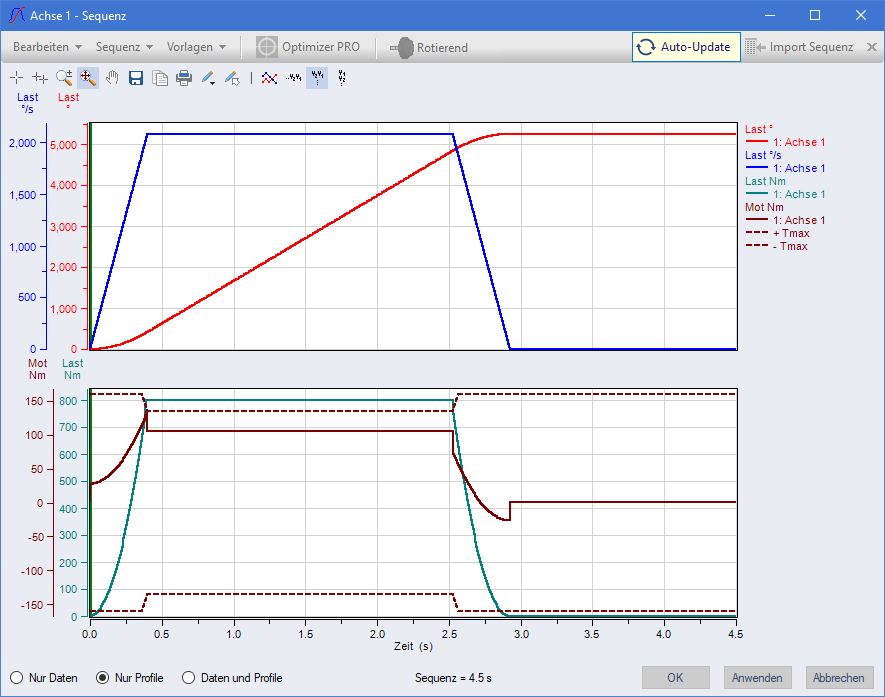Die "Auto Update" Funktion ermöglicht es, mit einem externen
Programm Achssequenzen vorzugeben und Leistungswerte in einem
XML-Export zu lesen. Das externe Programm kann ein Profilgenerator
und/oder Optimierungstool sein, das die Sequenz mit jeder Iteration
anpasst. Der XML-Export enthält alle wichtigen Leistungsdaten
einschließlich Motorspitzenmoment/-kraft, Motordauermoment/-kraft,
Umrichterspitzenstrom, Umrichterdauerstrom,
Einspeisespitzenleistung, Einspeisedauerleistung,
Bremstransistorspitzenleistung, Bremstransistordauerleistung
usw.
Schritt 1: Um den Vorgang zu starten, laden Sie
eine Sequenz als Textdatei mit Hilfe der Funktion Sequenz importieren. Dann erscheinen die
Buttons "Auto Update" und "Import Sequenz".
Schritt 2: Danach klicken Sie auf den "Auto
Update" Button in der Kopfzeile. Solange der Auto-Update-Modus
aktiv ist, blinkt der "Auto Update" Button, während die
Sequenz-Seite auf eine Änderung der Sequenzdatei wartet.
Schritt 3: Sobald eine geänderte Sequenzdatei
erkannt wird, wird sie sofort geladen und berechnet, danach werden
die Hauptleistungsdaten in eine XML-Berichtsdatei geschrieben.
Schritt 4: Das externe Programm kann die
XML-Berichtsdatei lesen, eine neue Sequenz berechnen, eine neue
Sequenzdatei schreiben und so weiter. Somit kann die Sequenz
entsprechend der Parameter des externen Programms optimiert
werden.
Schritt 5: Wenn der Prozess abgeschlossen ist,
deaktivieren Sie die Schaltfläche "Auto Update" Buttons zum
normalen Modus zurückkehren, wobei die Sequenz dem letzten Stand
der externen Einstellungen entspricht.

The XML report file returned by the program includes extensive
detailed performance information for all components in each slot in
the power group. The XML report files are in the same folder as the
Seq.txt file in the "Reports" subfolder.
One of the first elements in the report is the Power Group
element:
<PowerGroup>
<PowerGroupNumber>1</PowerGroupNumber>
<PowerGroupDescription>Power
Group</PowerGroupDescription>
<U_OverallStatus>CRITICAL</U_OverallStatus>
<U_Overall>91.5655521151247</U_Overall>
</PowerGroup>
In general, this is the first place the optimization tool will
look before probing the XML file for more details. If there is a
Critical alarm and/or the overall utilization is too high, then the
optimization tool may pass on the current sequence and try another.
If there is a Warning or Critical status, the status element will
be <U_OverallStatus>CRITICAL</U_OverallStatus>.
This is the Motor element included in the XML report file:
<Motor>
<Vendor>ABC</Vendor>
<Model>DG56A65</Model>
<Type>PMSM</Type>
<CoolingType>Natural
convection</CoolingType>
<U_OverallStatus>CRITICAL</U_OverallStatus>
<U_Overall>91.5655521151247</U_Overall>
<U_PeakTorque>79.3798735670792</U_PeakTorque>
<U_ContTorque>72.1486428639502</U_ContTorque>
<U_I2t>91.5655521151247</U_I2t>
<InertiaMismatch>1.85379784313725</InertiaMismatch>
</Motor>
The key performance elements are the Utilization (U) elements.
In this case, the motor's I2t has the highest utilization with
91.5656%, and therefore is the value used for overall utilization,
<U_Overall>. In this case, the motor's status is Critical as
shown by <U_OverallStatus>CRITICAL</U_OverallStatus>.
This implies that the motor's I2t margin limit is likely 10%. Ie.
I2t >90% is considered a critical alarm in this example.
So let's take the same example as above, but in the project, set
the motor's I2t margin limit = 5%. In this case, the Power Group
and Motor elements are shown, now with
<U_OverallStatus>OK</U_OverallStatus>, indicating the
power group and motor are OK with no margin limits exceeded.
<PowerGroup>
<PowerGroupNumber>1</PowerGroupNumber>
<PowerGroupDescription>Power
Group</PowerGroupDescription>
<U_OverallStatus>OK</U_OverallStatus>
<U_Overall>91.5655521151247</U_Overall>
</PowerGroup>
<Motor>
<Vendor>ABC</Vendor>
<Model>DG56A65</Model>
<Type>PMSM</Type>
<CoolingType>Natural
convection</CoolingType>
<U_OverallStatus>OK</U_OverallStatus>
<U_Overall>91.5655521151247</U_Overall>
<U_PeakTorque>79.3798735670792</U_PeakTorque>
<U_ContTorque>72.1486428639502</U_ContTorque>
<U_I2t>91.5655521151247</U_I2t>
<InertiaMismatch>1.85379784313725</InertiaMismatch>
</Motor>
Similar performance details are provided for Inverters, Infeed,
Bleeder and ESM modules, as well as Gearboxes and Transformations,
Linear Actuators, Pumps, and other mechanisms, for all slots in the
power group.
 Optimierungsvorgang
Optimierungsvorgang
 XML Report
XML Report